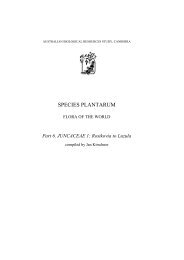Part 7. JUNCACEAE 2: Juncus - Species Plantarum Programme
Part 7. JUNCACEAE 2: Juncus - Species Plantarum Programme
Part 7. JUNCACEAE 2: Juncus - Species Plantarum Programme
Create successful ePaper yourself
Turn your PDF publications into a flip-book with our unique Google optimized e-Paper software.
40<br />
SPECIES PLANTARUM — FLORA OF THE WORLD (2002)<br />
apex, 0.4–1.0 mm wide; apex acute; auricles absent. Lower bract filiform, 0.3–1.5 cm long,<br />
shorter than or rarely longer than inflorescence; capitulum bracts scarious, to c. 2 mm long,<br />
scabrid on midrib. Inflorescence umbelloid to rarely anthelate, of 1–10 (–20) heads; heads<br />
2–8-flowered, c. 4–5 mm wide. Tepals unequal, ±narrowly ovate; outer tepals (1.0–) 1.2–1.5 mm<br />
long, acute to broadly-acute, mucronate, without hyaline margins; inner tepals 1.3–1.8 × 1.0 mm,<br />
rounded-obtuse, with broad whitish margins. Stamens 6, rarely 3 or 4; anthers (0.4–) 0.6–0.8 mm<br />
long; filaments 0.4–0.7 mm long; style 0.2–0.5 mm long; stigmas 0.3–0.8 mm long, pale yellow.<br />
Capsule ellipsoid to ovoid, subobtuse, shortly mucronate, dark golden brown to red-brown near<br />
apex, 1.5–2.0 mm long, distinctly longer than perianth. Seeds broadly ovoid, 0.4–0.6 mm long,<br />
0.2–0.3 mm wide, pale castaneous, faintly reticulate; appendages absent. Fig. 51.<br />
Endemic in Western Australia. 50: WAU. In damp places. Map 195.<br />
50. WESTERN AUSTRALIA: [without locality], J.Drummond 103 (W); Nornalup village, K.L.Wilson 9038 &<br />
K.Frank (CHR, K, NSW, PERTH); Albany, Sep 1902, C.Andrews s.n., (NSW50048); Bluff Knoll, 4 May<br />
1975, G.J.Keighery UWA1975 (NSW, UWA).<br />
The number of stamens is usually 6, but occasionally varies from 3 to 6 on the same plant.<br />
A few plants appear intermediate between this and J. planifolius, which may suggest<br />
hybridisation. Outer tepals are always narrower and less obtuse than the inner ones, which<br />
have broad whitish margins.<br />
18. <strong>Juncus</strong> antarcticus Hook.f., Fl. Antarct. 1: 79, tab. 46 (1844).<br />
T: Campbell’s Island, 1200 ft, J.D.Hooker 1623; lecto: K, fide E.Edgar, in L.B.Moore & E.Edgar, Fl. New<br />
Zealand 2: 69 (1970); iso: BM, MEL s.n., NSW s.n., UPS.<br />
<strong>Juncus</strong> pauciflorus Kirk, Trans. & Proc. New Zealand Inst. 9: 551 (1877), nom. illeg., non R.Br. (1810);<br />
<strong>Juncus</strong> brevifolius Kirk, Trans. & Proc. New Zealand Inst. 14: 384 (1882), nom. illeg., non R.Br. (1810).<br />
T: New Zealand, Castle Hill Basin, Broken River, T.Kirk; holo: WELT11170; iso: K [as T.Kirk 630].<br />
Illustration: J.D.Hooker, Fl. Antarct. 2(1): pl. 46 (1844).<br />
Perennials, 1–5 (–12) cm tall, dwarf, loosely caespitose, turf-forming; rhizomes thin, c. 1 mm<br />
in diam., vertical and ascending, branched or many-headed; stolons ±absent. Leaves basal<br />
and sub-basal, ±flat to canaliculate, distally canaliculate to subinvolute, almost terete near<br />
apex, to 2–3 cm long, c. 0.5–0.9 mm wide near base; margins ±smooth and narrowly hyaline;<br />
apex ±obtuse to subobtuse, rarely minutely mucronate; sheaths loose, open, c. 4–8 mm long,<br />
with margins distinct, membranous; auricles absent. Bracts ±ovate, acuminate, pale<br />
castaneous-brown to brownish scarious, 2–6 mm long, shorter than or equalling<br />
inflorescence. Inflorescence terminal, c. 1 cm long, of a 2–10-flowered head; flowers on<br />
pedicels to c. 1.2 mm long. Tepals ±equal, 2.5–3.5 mm long, usually dark castaneous-brown,<br />
with a paler brownish-membranous border or unbordered, acute to acuminate; outer tepals<br />
±lanceolate, carinate, 3-veined; inner tepals ovate-lanceolate. Stamens 3, rarely to 6; anthers<br />
0.5–0.7 mm long; filaments 1.0–1.2 mm long; style c. 0.2 mm long; stigmas c. 0.6–0.8 mm<br />
long. Capsule narrow-ellipsoid, ±trilocular, subtrigonous, subabruptly narrowing into a short<br />
mucro, c. 2.8–3.1 mm long, golden brown to very dark red-brown, usually darker near apex,<br />
shorter than or equalling perianth. Seeds broadly ovoid, pale brown, 0.4–0.6 × 0.35 mm,<br />
distinctly transversely reticulate; appendages absent. Fig. 51.<br />
In Australia (Tasmania, Victoria and New South Wales), and New Zealand (North, South,<br />
Stewart and subantarctic Islands). 50: NSW, TAS, VIC. 51: ATP, NZN, NZS. Boggy ground,<br />
mostly at altitudes above 500 m but down to sea-level in southern New Zealand and<br />
associated islands. Map 196.<br />
50. NEW SOUTH WALES: Rawsons Pass, Kosciusko National Park, 19 Mar 1974, R.Coveny 5376, (CHR, K,<br />
L, LE, MEL, NSW, RSA); base of Mt Piper, near Smiggins – Guthega road, Kosciusko National Park, 23 Jan<br />
1976, J.Thompson 2438B part, (CANB, CHR, K, L, MEL, NSW,). TASMANIA: Pelion Gap, Cradle Mtn,<br />
Lake St Clair N.P., 26 Mar 1992, K.L.Wilson 8366, (CHR, HO, NSW). VICTORIA: Watchbed Ck, Bogong<br />
High Plains, 27 Jan 1966, A.C.Beauglehole 15642 (NSW). 51. NORTH IS.: Wellington, Tararua State<br />
Forest Park, Tararua Range, NW of Powell Hut, Mt Holdsworth area, 1320 m, W.R.Baker, E.Vitek & al. 38-1 (W).<br />
SOUTH IS.: South Is., Canterbury, Thomas River, T.Kirk 1043 (WELT11143); Table Hill, Stewart Island,<br />
R.Melville 6291 & E.F.Melville (K, NSW). ANTIPODEAN IS.: Auckland Island, Carnley Harbour, T.Kirk<br />
1212 (K).












